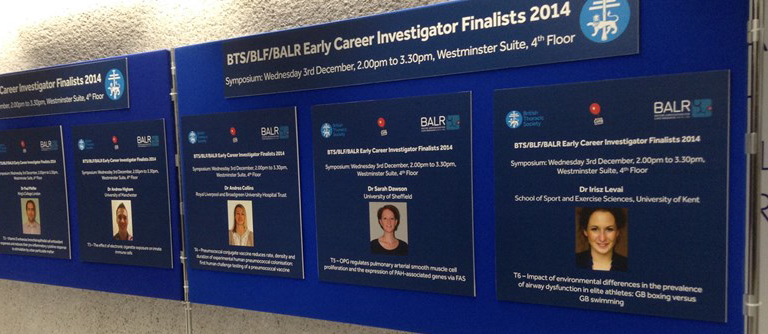British Thoracic Society (BTS), British Lung Foundation (BLF) and British Association of Lung Research (BALR) jointly offer awards to help the careers of the most promising early career investigators carrying out original research in respiratory medicine and respiratory science during the past year.
To qualify for consideration applicants must be a UK based clinical or non-clinical researcher, usually under the age of 35 (but not consultant or senior lecturer grade), and the first named author of the abstract being submitted to the Winter Meeting. The committee offer three first prizes of £800 and three prizes of £200 for runners up. This year, 6 finalists were selected from a total of 201 applicants, from a particularly strong field.
Our abstract entitled ‘Impact of Environmental Differences in the prevalence of airway dysfunction in Elite Athletes: GB Boxing VS GB Swimming’, was accepted as a finalist for the Prize. We were pleased and honored to have been given the opportunity to present our research work during the Early Career Investigator of the Year Prize Symposium on Wednesday 3rd December 2014 in London. At the event Dr Irisz Levai received the “Highly Commended runner-up” award from the British Lung Foundation.
The study was conducted between July 2013 and March 2014 and took place at the English Institute of Sport, Sheffield (GB Boxing), Loughborough University and University of Bath (GB Swimming). The purpose of our study was to evaluate the airways response to hyperpnoea in elite athletes from GB Boxing and GB Swimming that train in different environmental conditions. Hyperpnoea-Induced Bronchoconstriction (HIB) was evaluated in 39 GB boxers and 33 GB swimmers. First we asked participants to complete a questionnaire that asked whether they experienced any exercise respiratory symptoms (such as coughing, excess mucus production, dyspnoea, chest tightness or wheezing) and had a previous diagnosis of asthma/Exercise-Induced Bronchoconstriction (EIB). The athletes then underwent a full respiratory assessment including the following tests: (FeNO) – to measure the level of Nitric Oxide in the exhaled breath; (Spirometry) – to measure the maximum flow and volume of air that can be inhaled and exhaled from the lungs and an (EVH challenge) – a 6-minute breathing test during which the athlete breathes a cold, dry gas mixture (21% O2, 5% CO2, 74% N2) at very high ventilation rates (~85% of MVV). Airway function following the test was compared against normal resting airway function. This is the first study to specifically screen large cohorts of GB Swimming and GB Boxing athletes using an indirect bronchoprovocation challenge. We found a nine fold greater prevalence of HIB in elite swimmers when compared with boxers.

